"This is Narnia," says Hazel Shaw as she opens a big blue wardrobe on the first floor of the multicoloured co-working space Tara Buildings, painted by the street-artist Maser. The back of the wardrobe opens out on to a metal stairway, which leads to a wood-floored roof surrounded by flower boxes and lit by light bulbs strung overhead.
“We do yoga up here in the summer and mindfulness meditation,” says Shaw, the front-of-house manager here.
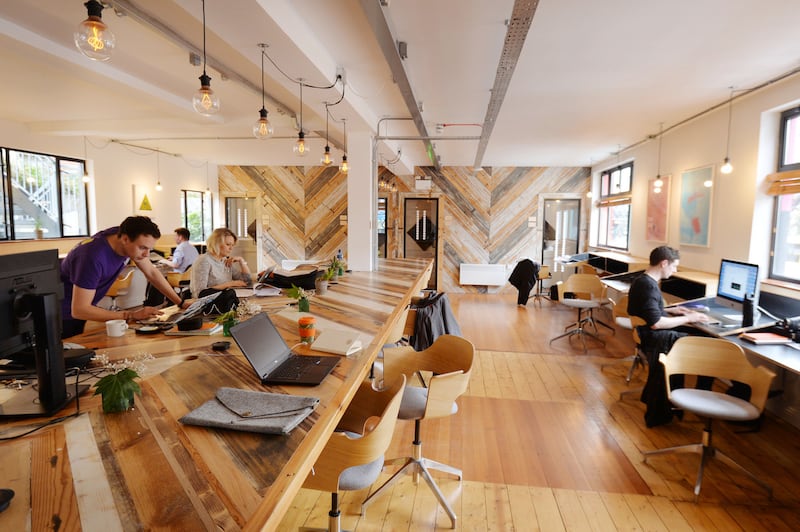
Tara Buildings is home to 70 young “creatives” who labour creatively amid the pleasantly zig-zagging wood panels, fold-out “homework desks”, exposed light bulbs, plants and lockers all positioned there by the designer Jill L’Estrange. They hope to raise that number to 100. For €220 per month, people get 24-hour access to the building to work here and make use of the various meeting rooms, yoga classes, events and talks (some people come in on a free trial “scholarship”).
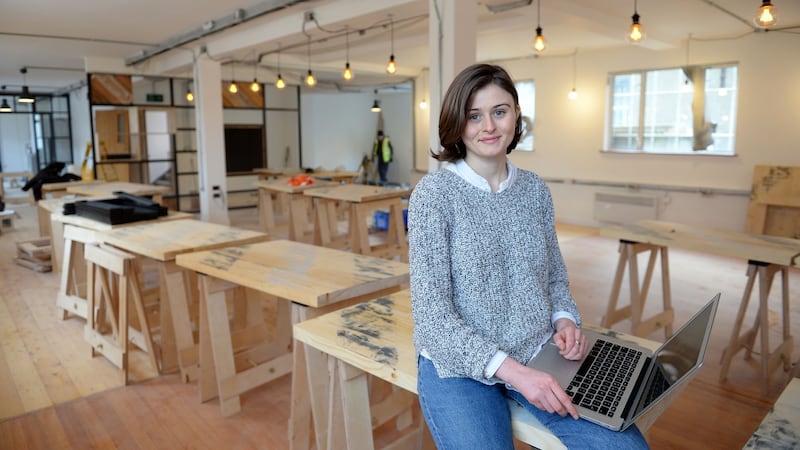
On the slightly quieter first floor there are more desks, Polaroids of a selection of members on the wall (“some people were resistant,” says Shaw), little booths for private phone calls and a blackboard that hosts a new illustration each month. This month’s picture is rendered by illustrator Fiona O’Broin and features Super Mario. In theory everyone “hot-desks” using whichever desks are free. In practice, people have preferences.
"There's one desk down there that's the most coveted in the place," says architect Rae Moore.
"Prime real estate," agrees marketing man Stephen Bury.
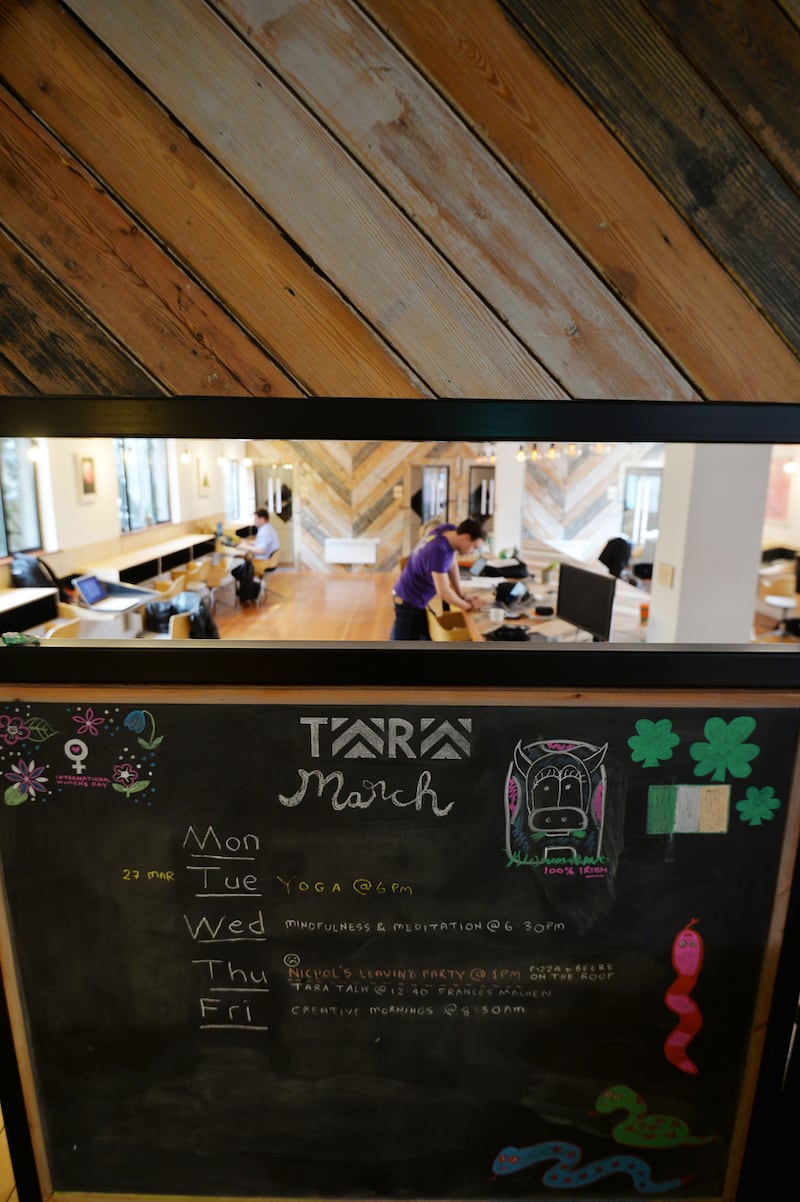
The community began when former manager Nichol Gray hosted art project In Place, about making artistic use of Dublin's vacant spaces. Subsequently she and the landlord Luke Keily came up with the idea of hosting something more permanent.
“Nichol’s vision for it was a really creatively focused community,” says Shaw. “So this isn’t just where people work – it’s where they come to meet people and to collaborate, to share skills and ideals.”
Community is prized here. Down at a kitchen stocked with free coffee, fruit and bread, and framed illustrations by Fuchsia MacAree, some of the members articulate why they spend €220 a month for this rather than work at their kitchen tables.
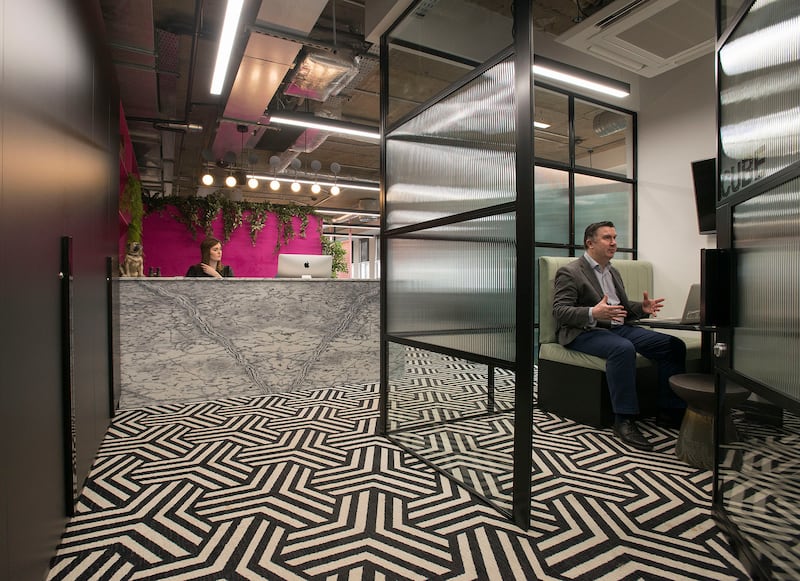
“You want to get out of the house, so you’re not eating sandwiches all day,” says Bury, who happens to be making a sandwich. “And I think it’s motivating seeing other freelancers working away, working hard.”
“I worked in quite big architecture firms,” says Moore. “Here everyone is creative and self-employed. If you have worked in a large office, you’ll know that feeling when the boss enters the room and the air just disappears. There’s no moment like that here.”
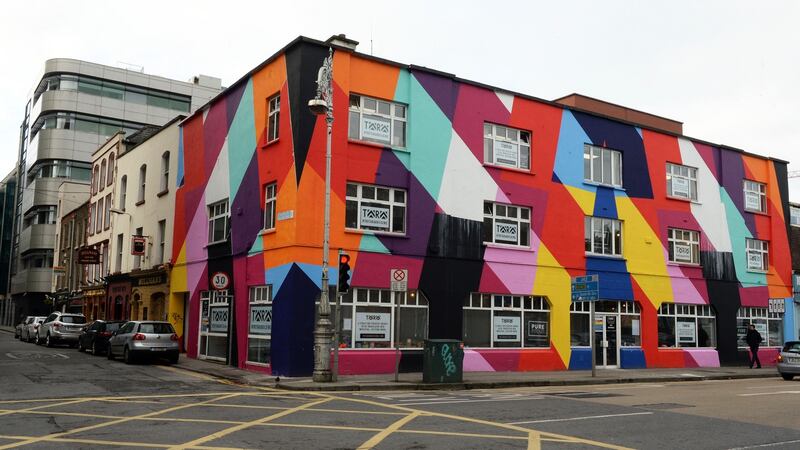
Inflexible hours
She refers instead to the importance of informal chats in the stairwells and the kitchen or at the free yoga classes “where we entertain each other with how inflexible we are”.
Many of them have found collaborators and clients here. Behind Moore there’s a whiteboard on which various “Tarareans” (that’s what Moore calls them) can seek help on projects. “A photographer and writer here are doing a piece of work based on something I presented last year, which I’m intensely flattered by,” says Moore. “And my biggest job at the moment is one that came to me through a contact I met here … It is in fringe moments when you take an hour out that new ideas arise. That’s as important as being locked to a desk. At the end of the day that’s not what we’re here for.”
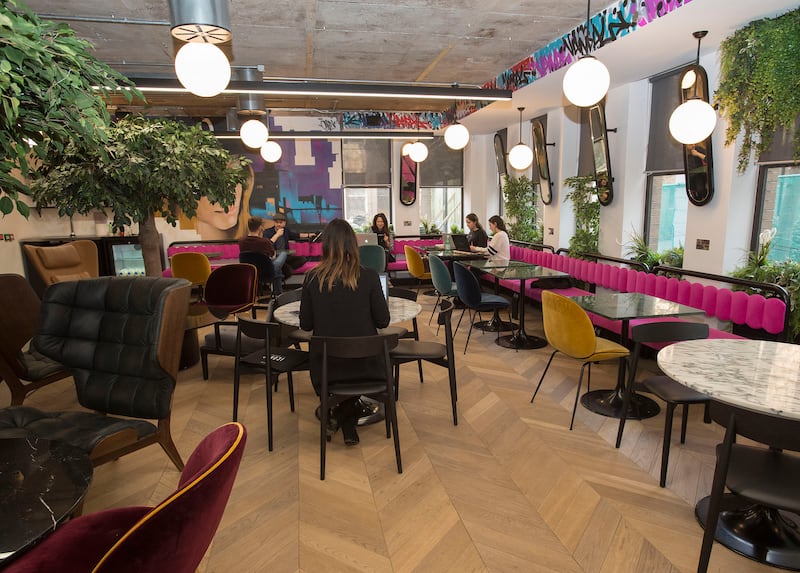
Do they find it hard to work in an open-plan environment?
“No,” says Moore. “You just put headphones on.”
“Someone worked out there were one or two times during the day when everyone comes to life,” says O’Broin. “Just before lunchtime and then around 4. It’s like the radio going on.”
There is a sense of community, they say. “We go out for drinks,” says Moore.
Shaw is aware of an influx of other, more corporate co-working organisations but says Tara is different. They host a lot of people from the creative industries, she says, and they focus on “wellness. We prioritise people looking after themselves. Freelancers can work 80-hour weeks and not think about it. We try to get people to stop and look after each other.
“The feedback we get is that we’re less corporate and more creative, relaxed.”
O’Broin puts it succinctly: “We’re more hippyish.”
The future of work
Work is changing. Technology means you can work from anywhere, and secure jobs with benefits are disappearing. Some futurists say that all work is disappearing. Against this backdrop a younger generation of employee is, inspired by the playground aesthetics of Silicon Valley, demanding better-quality workspaces. Co-working spaces have been popping up all over the city since the dark days of the recession and they are now, arguably, becoming a sort of norm. There are, to name just a few, Block T, The Chocolate Factory, Huckletree and Dogpatch. And now the international operator Wework, which is worth €20 billion and has 242 spaces in 71 cities, is opening three spaces in Dublin. The first launches in June.
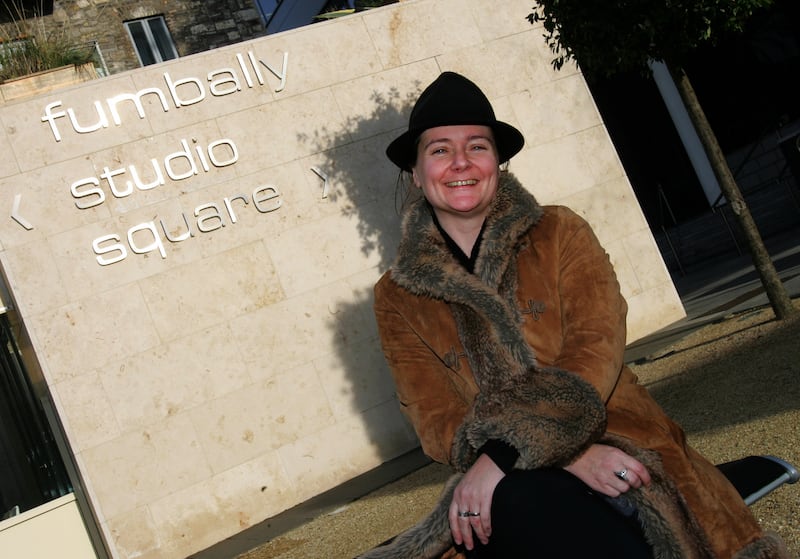
One of the earliest co-working spaces in Dublin was the Fumbally Exchange, which took the Metropolitan Exchange in New York as a model. "It was a recession response originally," says founder George Boyle. "It started in 2010. The company I was working with went out of business while I was on maternity leave and I realised there were hundreds of people out of jobs and I thought up this idea that we could all work together in the same space and pursue different aims and goals … It wasn't a commonplace idea then … In Fumbally Lane I had been head architect on a job. I knew the landlord well … He had 100sq ft with office space filled years before with lots of start-ups and they were all emptying out. I was given three years if I got it half full by Christmas. Within three weeks it was full. Within six months we had a separate premise of 60 entrepreneurs."
Fumbally now has three locations and unlike most of the newer operators, it is a not-for-profit enterprise. “We developed a mandate,” she says. “We were already helping people to scale and grow their business like an accelerator or an incubator and we were already using the creative capital in the room to help people make collaborative partnerships and help the community … We work on projects that are pinpointed at problems in the area.”
Ironically, while co-working is proliferating around the city, Fumbally is about to lose its city-centre location on Dame Lane to "an offer the landlord couldn't refuse".
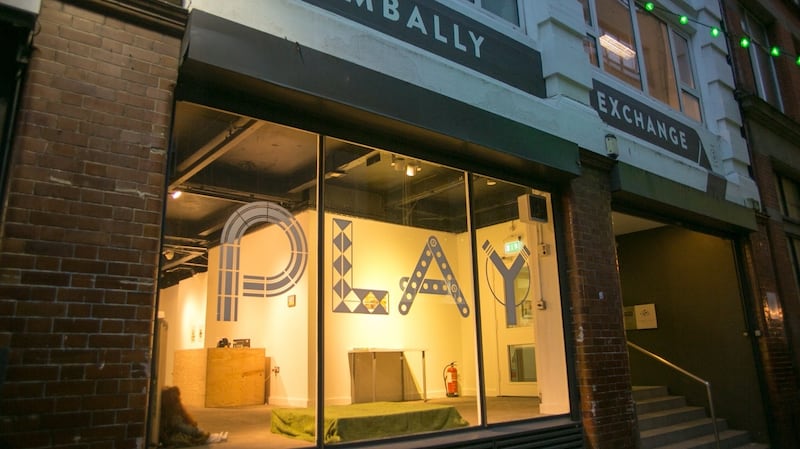
Co-working is changing, she says. She divides the current crop of co-working spaces into three types. Firstly, there are operators such as Fumbally who have a creative and community-focused mandate. Then, she says, there are situations where landlords temporarily allow people to use spaces on a casual basis. "Those have been around for ever. They got Temple Bar going, they got Silicon Valley going." She laughs. "They probably got the renaissance going."
And then there’s a third, newer type of operator that she calls “the pretenders”, who see a lucrative opportunity.
According to Pete Bacevice, who coruns an ongoing University of Michigan study called The Co-working Project, co-working is increasingly being recognised as a cheaper and less risky way to grow a business. He and his team have also, he says, found evidence that co-working spaces are better for morale compared with traditional offices ("thriving" is the word they use) and he recounts anecdotal evidence that it improves productivity and leads to collaboration (all the co-working websites emphasise "collaboration" and "innovation"). Because of this, he says, established businesses are increasingly setting up little colonies of their own employees in existing co-working hubs.
Mainstream model
In short, co-working is becoming less of a fringe entity and more of a mainstream business model. “I’m calling it ‘workplace as a service,’ ” he says. “It’s taking work and turning it into a product and experience you can package and sell.”
Joe McGinley, the founder of Iconic Offices, started out as an estate agent in search of a space for his own business when he decided that co-working was the future. Iconic Offices is now the biggest indigenous co-working operator in Ireland. Iconic Offices symbolise where co-working is headed. They now have 14 spaces and McGinley is currently working with Deloitte Ireland to raise equity to make the business international.

“It’s like the hotel sector, where you’d have your Hiltons and Radissons and then you’d have your Ace hotels and Hoxtons and then you have your boutique operators,” he tells me in a diner-style meeting room in their new “Greenway” office on St Stephen’s Green. “We’re the boutique operator.”
The Greenway was designed by Kingston Lafferty but every Iconic building has a unique design. Downstairs the lobby features a wall of fake greenery, a motif that's repeated on the other floors ("Imagine the maintenance if it was a real 'living wall,' " says press manager Róisín Moloney when I ask if these plants are real) and next door there's a cafe with the obligatory free breakfast, coffee and beer and a mural by the street artist Omen. "Joe loves his street art," says Moloney.
Upstairs on one of the co-working floors, people labour quietly among beautifully designed desks and exotically tiled phone booths. “Crush your goals,” declares a wall slogan. Another co-working room features porcelain animals and a shelf of classic science fiction books.
"It's very ready for Instagram, " jokes David Lawlor of the marketing firm Brand New Creative, who works here with his business partner, Amos Unkovich. Lots of the people I interview laugh about the cliches of fashionable modern workplaces – beanbags and graffiti and free beer – but Unkovich also rattles off statistics about increased productivity and collaboration. Ernst and Young even have a space upstairs, he says, and then he laughs, "but we don't fraternise with them".

The demographic in Iconic seem older and more established than in other co-working spaces I’ve visited in the past, with people in their 40s and 50s and sectors ranging from aviation to financial services. “It’s not full of kids sitting on crates drinking free beer,” says McGinley. “It’s older, serious working people who have jobs to do.”
On-site socialising
Collaboration is cultivated by “community managers”, there are yoga classes and business talks and, as in other spaces, people seem to socialise on site. “I went down to the cafe when I was working here last Friday,” says architect Courtney O’Donnell. “And it was like a rave.” She goes on to describe an apres-ski themed Christmas party where the waiting staff were dressed like skiers.
The Instagram-able nature of these spaces is not to be sniffed at, says McGinley. He talks about a wave of hard-to-retain young workers who have imbibed the Silicon Valley Kool-Aid and expect their workspaces to be “funky”. Pete Bacevice also notes that such fripperies are taken as a norm by this new generation of “knowledge worker”, though, to add my own cynical note, when they get older they might be inclined to exchange ping-pong tables and free beer for job security and a pension (if such things still exist).
George Boyle, who is still seeking premises for the Fumbally Exchange, is stoical about the newer co-working operators but she stresses that they do not all share Fumbally’s more socially conscious aims, and she warns that standards could diminish over time. “It’s a real estate business,” she says, “and a merciless one on one level. [Some] are taking advantage of the concept while not understanding it or, if they do understand it, they leave out a few key ingredients.” She laughs. “A company dog, a pool table and a few beanbags don’t make a co-working space. There’s more to it than that.”











